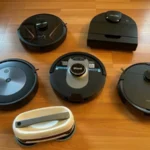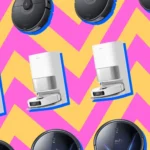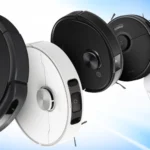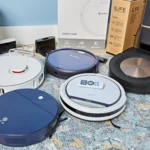Imagine coming home to the floors of your house being sparkling clean, without even having to lift a finger. Thanks to smart vacuum cleaners, this has become a reality. However, these small but powerful devices would not be possible without their reliable batteries. Understanding the charging cycles and battery runtime of your smart vacuum cleaner is essential to keeping your device running smoothly and maintaining its performance. In this article, we will delve into the battery basics, charging cycles, and battery runtime for smart vacuum cleaners, and provide you with tips to optimize and maximize the life of your device’s battery. Let’s get started.
Smart Vacuum Cleaner Battery Basics

When it comes to understanding the charging cycles and battery runtime of smart vacuum cleaners, it’s important to first grasp the basics of their batteries. After all, the battery is the heart of the smart vacuum cleaner, powering its movements and suction. In this section, we’ll dive into the essential information you need to know about smart vacuum cleaner batteries, including the different types available, how they work, and how to maintain them for optimal performance. For more information on the importance of checking your smart vacuum’s battery, check out our article on the importance of checking your smart vacuum’s battery.
Understanding Battery Types
When it comes to understanding the charging cycles and battery runtime for smart vacuum cleaners, it is crucial to have a good understanding of the types of batteries that are typically used. Here are the most common types of batteries used in smart vacuum cleaners:
- Lithium-ion Batteries: These batteries are becoming more popular in smart vacuum cleaners, and for many good reasons. They offer faster charging times, higher energy density, and longer lifespan than other types of batteries. They are also more resistant to memory effect which can affect the battery's performance over time. You can learn more about lithium-ion versus NiMH batteries for smart vacuums in this article.
- Nickel-Metal Hydride (NiMH) Batteries: These were the most commonly used batteries in vacuum cleaners before lithium-ion became more widely available. While they can still be found in some models, they are generally less energy-dense than lithium-ion batteries, meaning they don’t last as long on a single charge. They can also be susceptible to “memory effect” if not charged properly. You can learn how to check the battery status of your smart vacuum cleaner battery in this article.
- Nickel-Cadmium (NiCd) Batteries: These batteries are relatively rare in smart vacuums these days, as they are heavy, toxic, have low energy density, and are prone to memory effect. If you are having issues with your smart vacuum cleaner battery, you may want to read this article for some common troubleshooting tips.
It’s essential to note that the type of battery used can impact factors like charging time, battery lifespan, and overall smart vacuum cleaner performance. As such, it’s worth taking the time to understand what type of battery your smart vacuum uses and familiarizing yourself with best practices for charging and maintenance. To learn about preventing battery degradation and maximizing battery life for your smart vacuum cleaner, check out this article. Additionally, for signs it’s time to replace your smart vacuum battery and how to maximize battery life and performance, read this article.
How Batteries Work
Batteries are essential for smart vacuum cleaners to operate, but how do they work exactly? Let’s dive into the science behind it.
What are batteries?
Batteries are devices that store chemical energy and convert it into electrical energy. This electrical energy is used to power the motor and other components of the smart vacuum cleaner.
How do batteries work?
Inside a battery, there are two electrodes – a positive and a negative one – separated by an electrolyte. When the battery is connected to a circuit, a chemical reaction occurs between the electrodes and the electrolyte. This results in the movement of electrons from the negative electrode to the positive one, generating an electrical current.
Battery chemistry
Different types of batteries use different materials for their electrodes and electrolytes, resulting in varying chemical reactions. The most common types of batteries used in smart vacuum cleaners are lithium-ion and nickel-metal hydride batteries.
Lithium-ion batteries have a higher energy density and are lighter, making them popular for portable devices. They also have a longer lifespan and are less prone to memory effect.
Nickel-metal hydride batteries, on the other hand, are cheaper and have a lower environmental impact. However, they have a shorter lifespan and are more susceptible to memory effect.
Battery lifespan and performance
The lifespan and performance of a battery depend on various factors, such as the quality of materials used, usage pattern, and maintenance. Over time, a battery’s capacity decreases due to chemical degradation, resulting in a shorter runtime for the smart vacuum cleaner.
To ensure optimal battery performance, it’s important to follow the manufacturer’s guidelines for charging and maintenance. This includes avoiding deep discharges, using the correct charger, and storing the battery in a cool and dry place.
In the next section, we’ll discuss the various charging cycles for smart vacuum cleaners and how they impact battery performance. But first, let’s take a look at the different types of batteries used in smart vacuum cleaners in the table below.
| Battery Type | Chemistry | Pros | Cons |
|---|---|---|---|
| Lithium-ion | Lithium cobalt oxide | High energy density, long lifespan, less memory effect | Expensive, sensitive to high temperatures |
| Nickel-metal hydride | Nickel oxyhydroxide, metal hydride | Cheap, low environmental impact | Shorter lifespan, more memory effect |
For more information on signs that your smart vacuum cleaner’s battery needs replacement, check out our article on top signs for smart vacuum battery replacement.
Battery Capacity and Voltage
Understanding the battery capacity and voltage is essential when it comes to smart vacuum cleaners. Here are the key points to keep in mind:
- Battery Capacity: This refers to the maximum amount of charge a battery can hold, which is measured in milliampere-hours (mAh). The higher the mAh rating, the longer the battery will last on a single charge. Generally, smart vacuum cleaners with higher battery capacities can run for longer periods of time before needing a recharge.
- Battery Voltage: This refers to the electrical pressure that drives the current flow in the battery, which is measured in volts (V). The voltage rating of a battery determines the overall power output of the battery. In general, smart vacuum cleaners with higher voltage ratings will provide more power and operate more efficiently.
- Battery Chemistry: The type of battery used in a smart vacuum cleaner can also affect the battery capacity and voltage. Lithium-ion (Li-ion) batteries are the most common type of battery used in smart vacuum cleaners due to their high energy density and long life cycle. NiMH batteries are another common type of battery used in smart vacuum cleaners, which have a slightly lower energy density but are more affordable.
- Battery Replacement: Over time, the battery capacity and voltage of a smart vacuum cleaner will decrease due to aging and use. When it comes to replacing the battery, it’s important to choose a replacement battery with the same or higher capacity and voltage rating to ensure that the new battery performs as well as the original battery did when it was new.
Understanding the battery capacity and voltage of a smart vacuum cleaner is crucial for maximizing its battery life and performance. By choosing a vacuum cleaner with a high-capacity battery and voltage rating, and properly maintaining the battery, it’s possible to enjoy long runtimes and efficient cleaning abilities for years to come.
Charging Cycles for Smart Vacuum Cleaners
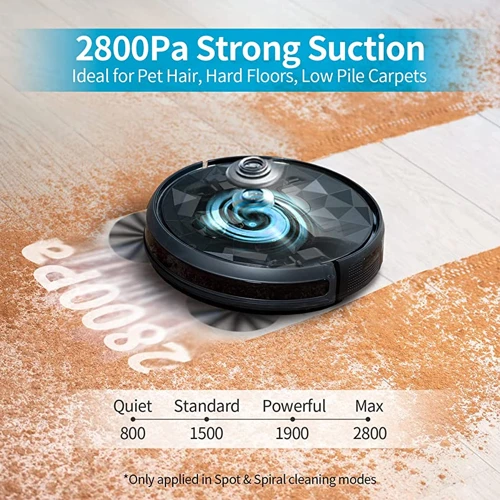
One of the essential aspects of owning a smart vacuum cleaner is understanding how to keep it fully charged and ready to go whenever you need it. With each use, the battery in your vacuum cleaner is drained, and it’s crucial to know how to charge it properly to ensure it maintains its efficiency and longevity. In this section, we’ll explore the ins and outs of charging cycles for smart vacuum cleaners, including pre-use charging, rechargeable batteries, charging time, charger safety, and optimizing charging cycles. So, let’s dive in and uncover some valuable information that will help you keep your smart vacuum cleaner running like new.
Pre-Use Charging
Before using a smart vacuum cleaner, it’s always recommended to charge it fully to ensure maximum battery life and runtime. Here are some key things to keep in mind regarding pre-use charging:
- Battery types: Depending on the type of battery in the smart vacuum cleaner, the pre-use charging time may vary. For example, lithium-ion batteries generally have shorter pre-use charging times compared to nickel-cadmium batteries.
- Charging time: It’s important to note that the charging time for a smart vacuum cleaner can vary depending on the model and manufacturer. Typically, it takes around 2-4 hours for a smart vacuum cleaner to fully charge.
- Charger safety: When charging your smart vacuum cleaner, it’s important to follow the manufacturer’s instructions and use the charger provided with the product. Using a non-compatible charger can harm the battery and even damage the vacuum cleaner. Additionally, it’s advisable to keep the charger away from water and other liquids to prevent any electrical hazards.
- Optimizing charging cycles: To ensure the battery of the smart vacuum cleaner is kept in good health, it’s recommended to only charge the device when it’s needed. Overcharging the battery can lead to a shortened lifespan of the battery. However, it’s important to not let the battery completely drain before charging as this too can damage the battery.
By keeping these factors in mind, you can optimize the pre-use charging process and help maximize the battery life of your smart vacuum cleaner.
Rechargeable Batteries and Memory Effect
Rechargeable batteries offer a cost-effective and convenient solution for powering smart vacuum cleaners. However, these batteries can experience a phenomenon known as memory effect which can reduce their performance and capacity over time.
Memory effect occurs when rechargeable batteries are not fully discharged before being recharged. This can cause the battery to “remember” the shortened runtime and only allow the vacuum cleaner to operate for that reduced time in the future. To avoid this, it’s important to fully discharge the battery before charging it back up. This can be done by running the vacuum cleaner until it shuts off on its own, and then charging it for the recommended time listed in the user manual.
Here’s a table to summarize some important information about rechargeable batteries and the memory effect:
| Term | Description |
|---|---|
| Rechargeable Battery | A type of battery that can be recharged and reused multiple times. |
| Memory Effect | A phenomenon that can occur when rechargeable batteries are not fully discharged before being recharged. This can cause a reduction in performance and capacity over time. |
| Fully Discharge | To use the battery until it is completely drained and the device no longer operates. |
| User Manual | The documentation provided by the manufacturer that outlines how to properly use and maintain a device, including charging and battery information. |
By properly maintaining the rechargeable battery in your smart vacuum cleaner, you can avoid memory effect and maximize its performance and capacity. Always follow the manufacturer’s instructions and recommendations for charging and battery care to ensure the longest battery runtime and lifespan for your device.
Charging Time
When it comes to charging time for smart vacuum cleaners, it is important to note that it can vary depending on the specific device and the type of battery it uses. However, there are some general guidelines to keep in mind.
- Lithium-ion batteries: These batteries typically have a shorter charging time than other battery types. On average, it takes around 2-3 hours to fully charge a lithium-ion battery for a smart vacuum cleaner.
- Nickel-metal hydride batteries: These batteries take longer to charge than lithium-ion batteries, with an average charging time of around 4-6 hours for a full charge.
- Nickel-cadmium batteries: These batteries take the longest to charge, with an average charging time of 6-8 hours for a full charge.
It is important to remember that charging times can also be affected by factors such as the age and health of the battery, the charging method being used, and the amount of charge left in the battery before starting to charge.
To ensure the quickest charging time possible, it is recommended to use the charger provided by the manufacturer and follow any specific instructions provided regarding charging times and safety precautions. It is also important to keep the charging area cool and well-ventilated to prevent overheating, which can damage the battery and potentially create safety hazards.
Understanding the charging time for the specific type of battery used in your smart vacuum cleaner can help optimize its performance and prolong the life of the battery.
Charger Safety and Best Practices
When it comes to charging your smart vacuum cleaner, safety should be your top priority. Following best practices can help prevent damage to your device and reduce the risk of accidents.
Here are some charger safety tips and best practices you should follow:
| Tip | Description |
|---|---|
| Use only manufacturer-approved chargers | Using a charger that is not approved by the manufacturer can cause damage to the battery or the device itself. |
| Keep your charger away from moisture | Water and electricity don’t mix, so keep your charger away from damp areas, such as bathrooms or swimming pools. |
| Avoid overcharging your battery | Overcharging your battery can cause it to overheat and damage the battery. Follow the manufacturer’s instructions on how long to charge your device for. |
| Don’t charge your device in extreme temperatures | Charging your device in extremely high or low temperatures can damage the battery and reduce its performance. Charge your device in a moderate environment. |
| Inspect your charger regularly | Check your charger for wear and tear, and replace it if there are any signs of damage. A damaged charger can be a safety hazard. |
| Unplug your charger when not in use | Unplugging your charger when you are not using it can help prevent a fire hazard in case there is a short circuit. |
By following these charger safety tips and best practices, you can ensure your smart vacuum cleaner stays safe and functional. Remember to always prioritize safety when it comes to charging your devices.
Optimizing Charging Cycles
One key aspect of maintaining the longevity and efficiency of your smart vacuum cleaner’s battery is by optimizing the charging cycles. By following the best charging practices, you can ensure that your vacuum cleaner’s battery is regularly charged and is always ready to perform when you need it the most.
Here are some tips for optimizing charging cycles for your smart vacuum cleaner:
| Tip | Description |
|---|---|
| Use the right charger | Make sure to use the charger that comes with your vacuum cleaner as using an incorrect charger can damage the battery and reduce its lifespan. |
| Avoid overcharging | Overcharging your vacuum cleaner’s battery can lead to overheating and potentially cause the battery to malfunction. Once your vacuum cleaner is fully charged, unplug it immediately to avoid overcharging. |
| Charge before the battery runs out | It is best to recharge your vacuum cleaner’s battery before it completely runs out of power. This helps to avoid a complete discharge and extends the battery life. |
| Keep battery cool | High temperatures can cause damage to your vacuum cleaner’s battery. It is recommended to charge your vacuum cleaner’s battery in a cool and dry place, away from direct sunlight or any other heat source. |
| Charge at the right time | It is best to charge your vacuum cleaner’s battery when you know that you won’t be using it for an extended period of time. This helps to maintain the battery level and prevents the battery from discharging completely. |
By following these simple yet effective tips, you can optimize your smart vacuum cleaner’s charging cycles, extending the battery life and ensuring that it is always ready to perform.
Battery Runtime for Smart Vacuum Cleaners
As smart vacuum cleaners become more advanced, understanding their battery runtime has become increasingly important for efficient usage. Modern-day vacuums require sufficient battery life to clean large spaces and maintain optimal performance. In this section, we will explore the various factors that impact battery runtime, including battery health and age, factors affecting runtime, and optimizing battery life and performance. By the end of this section, you will have a comprehensive understanding of battery runtime for smart vacuum cleaners and how to maximize it.
Average Runtime
When it comes to smart vacuum cleaners, the average runtime refers to the amount of time that the device can operate on a single charge. This is an important factor to consider when purchasing a vacuum cleaner, especially if you have a large home or if you need to clean for an extended period of time. Here are some key things to keep in mind regarding average runtime:
- Battery Capacity: The average runtime of a smart vacuum cleaner is directly related to the capacity of its battery, measured in milliampere-hours (mAh). As a general rule, the higher the mAh rating, the longer the device will be able to run on a single charge. Some top-of-the-line models can run for as much as two hours before requiring a recharge.
- Cleaning Mode: The cleaning mode that you choose can also impact the runtime of your vacuum cleaner. For example, if you opt for a high-power setting that is designed to pick up larger debris, the motor may consume more energy and decrease the amount of time that the device can run between charges.
- Floor Type: Another factor that can impact the runtime of a smart vacuum cleaner is the type of flooring that you have in your home. In general, cleaning thicker carpets or rugs may require more energy than hardwood or tile floors, and can therefore reduce the runtime of your device.
- Battery Health: Over time, the battery in your smart vacuum cleaner may begin to degrade, which can lead to a shorter runtime. It is important to properly maintain your device and replace the battery as needed in order to ensure optimal performance.
By paying attention to these various factors, you can get a better understanding of what to expect from the average runtime of your smart vacuum cleaner. Whether you have a small apartment or a sprawling estate, choosing a device that is capable of meeting your unique cleaning needs will help ensure that your home stays tidy and refreshing day after day.
Battery Health and Age
As with any type of battery, the health and age of the battery pack in your smart vacuum cleaner will play a significant role in its runtime and overall performance. Here are some important factors to keep in mind when it comes to your vacuum cleaner’s battery:
- Battery Capacity: Over time, your battery’s capacity will gradually decrease. This means that while a brand new battery may be able to provide 45 minutes of runtime on a single charge, an older battery may only last for 30 minutes or less. Keeping an eye on your battery’s capacity and replacing it when necessary can help ensure that your vacuum cleaner continues to run at its best.
- Battery Age: In addition to capacity, the age of your battery can also impact its performance. Over time, even if you don’t use your vacuum cleaner frequently, the battery’s chemical composition can change. This can result in a shorter runtime or even prevent the battery from holding a charge at all.
- Usage Habits: How you use your smart vacuum cleaner can also affect the health of its battery. For example, constantly running the vacuum on its highest power setting or letting it run until it’s completely dead can cause undue strain on the battery, leading to a shorter overall lifespan.
- Charging Habits: Similarly, how you charge your vacuum cleaner’s battery can also impact its health. Using the wrong charger or leaving the vacuum plugged in for too long can cause damage to the battery or even pose a safety risk.
- Storage: If you plan on storing your vacuum cleaner for an extended period of time, it’s important to take proper care of the battery. This may involve fully charging it and then disconnecting it from the vacuum to prevent it from being drained over time.
By keeping these factors in mind and taking proper care of your smart vacuum cleaner’s battery, you can help ensure that it continues to run efficiently and effectively. And if you do notice that your battery is starting to show its age, don’t hesitate to replace it with a new one in order to get the most out of your vacuum cleaner.
Factors Affecting Battery Runtime
The runtime of a smart vacuum cleaner battery is affected by several factors. Understanding these factors is crucial to optimizing the runtime of your vacuum cleaner. Below are some of the factors that can impact battery runtime:
- Battery Capacity: The capacity of a battery is one of the most important factors that affect its runtime. A high-capacity battery will run longer than a low-capacity one. The capacity of a battery is measured in milliampere-hour (mAh).
- Cleaning Mode: Some smart vacuum cleaners come with multiple cleaning modes that you can choose from. The runtime of the battery will vary depending on the mode you select. For instance, if you use the turbo mode, which consumes more power, the battery will drain faster.
- Surface Type: The surface you are cleaning can also impact the runtime of the battery. For example, if you are cleaning a carpet, the motor will have to work harder, which can drain the battery faster. On the other hand, when cleaning a hard floor, the motor will not have to work as hard. The battery will last longer.
- Battery Age: The age of a battery can also impact its runtime. As batteries get older, their capacity reduces, and they start to hold less charge. An older battery will not run as long as a new one, and it will not be able to hold a charge as well.
- Charging: The way you charge your battery can also impact its runtime. Charging for too long or using the wrong charger can reduce the battery’s overall lifespan, which can ultimately affect its runtime. It is essential to follow the manufacturer’s charging instructions to ensure the best performance of your vacuum cleaner battery.
By considering these key factors, you can increase the lifespan and runtime of your smart vacuum cleaner battery. Optimize your cleaning mode, consider the surface type you are cleaning, and make sure to follow the manufacturer’s charging instructions to ensure that your vacuum cleaner battery lasts as long as possible.
Maximizing Battery Life and Performance
To maximize the battery life and performance of your smart vacuum cleaner, there are several steps you can take:
- Use the right charger: It is important to use the charger that came with your smart vacuum cleaner. Using an incompatible charger can lead to a shorter lifespan for your battery.
- Avoid extreme temperatures: Extreme temperatures, whether hot or cold, can negatively impact your battery’s performance. Store your smart vacuum cleaner in a cool, dry place when not in use.
- Charge before storage: If you won’t be using your smart vacuum cleaner for an extended period of time, make sure to charge the battery fully before storing it to prevent it from fully draining and potentially damaging the battery.
- Optimize charging cycles: As we discussed earlier in this article, optimizing your charging cycles can extend the life of your battery. Follow the manufacturer’s recommendations for optimal charging cycles, which will vary depending on the type of battery in your smart vacuum cleaner.
- Use the right power mode: Using the highest power mode on your smart vacuum cleaner all the time can shorten battery life. Use the appropriate power mode for the task at hand to conserve battery life.
- Clean the filter: A clogged filter can cause your vacuum cleaner to work harder and drain the battery faster. Clean or replace the filter regularly to keep your smart vacuum cleaner running efficiently.
By following these steps, you can help extend the life of your smart vacuum cleaner’s battery and keep it running at peak performance for years to come.
Replacing Vacuum Cleaner Batteries
When the battery life of your smart vacuum cleaner deteriorates, it may be time to replace the battery. Here are the steps for replacing your vacuum cleaner battery:
- Choose the Right Battery: First, find out the type of battery required for your vacuum cleaner. Most smart vacuum cleaners use either Lithium-Ion batteries or Nickel-Metal Hydride batteries. Check the user manual or contact the manufacturer to confirm the correct battery replacement before going ahead with the purchase.
- Power Off the Vacuum Cleaner: Before replacing the battery, make sure your vacuum cleaner is powered off and unplugged from the charging dock.
- Access the Old Battery: To access the old battery, you may need to remove the battery compartment cover or unscrew the back panel of the vacuum cleaner. Again, check the user manual or contact the manufacturer for specific instructions.
- Remove the Old Battery: Once you have access to the battery, gently remove it from the vacuum cleaner by pushing the release tab or sliding it out of the holder. Be sure to handle the old battery with care and dispose of it properly in accordance with your local regulations.
- Insert the New Battery: Carefully insert the new battery into the holder or compartment. Make sure it fits snugly and securely in place.
- Replace the Cover and Test: Replace the battery compartment cover or back panel of the vacuum cleaner and securely tighten any screws. Now, press the power button to turn on the vacuum cleaner and confirm if the new battery is correctly installed.
Remember, battery replacement is not always necessary. Sometimes, it may be more cost-effective to replace the entire vacuum cleaner. However, if you do decide to replace the battery, ensure you handle it with care and follow the manufacturer’s instructions for safe and proper installation.
Conclusion
In conclusion, understanding the charging cycles and battery runtime for smart vacuum cleaners is crucial for maintaining and optimizing the performance of your device. By choosing the right battery type, monitoring the charging cycles, and taking care of your charger, you can extend the battery life and maintain consistent suction power.
It is important to note that battery health and age are also significant factors that can impact the overall runtime of the smart vacuum cleaner. So, it is best to ensure that you are using your device properly and maintaining it regularly to extend the lifespan of the battery.
Finally, if you ever need to replace the battery of your smart vacuum cleaner, make sure to choose a high-quality replacement that is fully compatible with your device. And, always follow the manufacturer’s instructions for proper installation and disposal of old batteries.
In summary, taking care of your smart vacuum cleaner’s battery can help you get the most out of your device and ensure that it continues to perform at its best. So, be proactive in your battery maintenance and enjoy a clean, dust-free home with your smart vacuum cleaner.
Frequently Asked Questions
What are the different battery types used in smart vacuum cleaners?
Smart vacuum cleaners use different batteries such as NiMH, Li-ion, and Li-Po depending on the manufacturer and model.
What is battery capacity?
Battery capacity is the amount of electric charge that a battery can store during the charging process.
What is voltage?
Voltage refers to the electric potential difference between two points, and it affects the overall power output of the battery.
When should I charge my smart vacuum cleaner before use?
You should charge your smart vacuum cleaner before the first use according to the manufacturer’s instructions, which typically involves charging the battery for several hours or until it is fully charged.
What is memory effect in rechargeable batteries?
Memory effect is a phenomenon that occurs when a battery’s performance is reduced due to repeated partial charging cycles.
How long does it take to charge a smart vacuum cleaner battery?
The charging time for a smart vacuum cleaner battery depends on the battery capacity and the charger’s output power. Typically, it takes several hours to fully charge the battery.
Are there any safety concerns when charging a smart vacuum cleaner?
Yes, you should follow the manufacturer’s safety instructions for charging your smart vacuum cleaner, including not charging it near water, keeping the charger and cord away from heat sources, and using only the provided charger.
What factors affect the runtime of a smart vacuum cleaner battery?
The battery runtime can vary depending on factors such as the suction power, the cleaning mode, the floor type, and the battery age and health.
How can I maximize the battery life and performance of my smart vacuum cleaner?
You can maximize the battery life and performance by reducing the suction power or using the eco mode, cleaning or replacing the filters regularly, and avoiding exposing the battery to extreme temperatures.
Can I replace my smart vacuum cleaner battery?
It depends on the manufacturer and model. Some models have replaceable batteries, while others have built-in batteries that cannot be replaced. Check the manufacturer’s instructions for more information.

